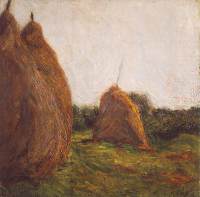
Hollósy's third period of art is related to Técső, a small village where he ran a summer art school for pupils of his academy in Munich until his death. His main genre was landscape at that time where he used impressionism adjusted to his character full of temperament in an individual style of his own. One of his favourite subject matters was hay stacks overtowering the green field. He painted a variety of them either closer or from a distance. His brushwork, grandiose and excited, always reflected the character of the landscape accurately. "There is harmony in nature: the atmosphere is colourful, thus the sky is green, and the field has purple reflexes, too," he would say to his pupils. He integrated complementary pairs of colours with pastose brushwork in order to avoid small dots of pointillism. With this technique, he managed to portray masses and vibration of air. The objective vision of nature was accompanied by a lyric interpretation always important for him. Hay Stacks, one of his most colourful pictures, recalls van Gogh with wild broken brushwork.